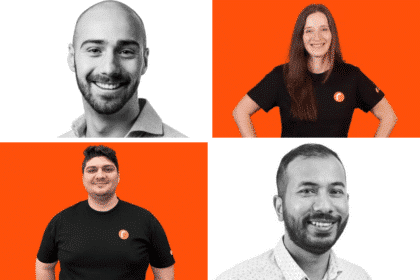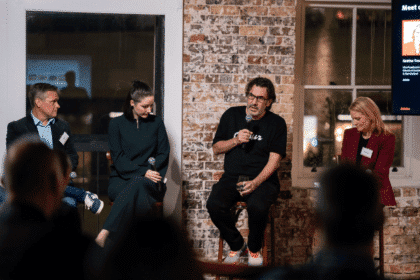Here, McCann Australia chief strategy officer, Simon McCrudden (main photo) and SMART managing partner, Bob Price (pictured below) converse on human centred design, its role in our new world and whether we’re truly taking advantage of the impact putting people at the centre of our work has….
Human Centred Design. It’s become part of marketing lexicon over the past few years, and during these pandemic-altered times we increasingly see the phrase dropped into briefings and strategy discussions of marketers and their organisations. But are we truly taking advantage of the power putting people at the centre of our work, or it is just another buzzword being paid lip service?
We sat down with Simon McCrudden, Chief Strategy Officer with McCann Australia, and Bob Price, Managing Partner at SMART – both strategic leaders within the newly formed HERO group of independent agencies – to discuss Human Centred Design and its role in our new world:
We hear a lot of talk about the importance of Human Centred Design in creating consumer strategies. How does it form part of your thinking?
Bob Price: A lot of clients are talking about Human Centred Design (HCD) but in many cases confuse it with simply being human-centric. There is a lot of HCD talk – but not a lot of doing!
Understanding the underlying needs of people and the truth that underpins those needs is our first priority, but the need to lead those conversations in terms of innovation is also a significant part of our role.
Simon McCrudden: You know, being human centred is a natural thing for most comms strategists in terms of insights and messaging. But thinking more broadly about how we ‘design’ touchpoint strategies is also critical. Most people tell surveys that they don’t like or care for advertising. So, how do we design communications? If we are to truly be human centred in our work and are going to interrupt what people are doing, our starting point needs to be that what we produce should be entertaining or useful as a bare minimum. Otherwise, its organisation centred – what we want to say – rather than human centred – what I want to hear.
What are the practical differences between what you do and the HCD process? Why is the difference important?
BP: Human Centred Design involves very specific processes. We work with great HCD specialists who bring huge value in understanding how we can best impact human behaviour.
Our work more often involves the need to also uncover the brand truth and marry the two together. This balancing act requires us to look at the business problem or opportunity from both the human and brand POV.
Technology seems to play a significant role in the implementation of HCD. How do you respond to briefs or client requests that feature this idea?
SM: Smart technology gives organisations the ability to deliver better services for their customers. But we also know that in this technologically driven age, our desire for human interaction has never been greater. The best modern technologically driven brands, are those that also display the greatest humanity.
BP: Totally agree. We see many client briefs these days that are more user-centred than human centred from a tech POV – finding the way to make technology work first. The “fix what we have” mentality. We like to step back and start with people and their needs first.
There is a lot of evidence about the role that distinctiveness and creativity plays in driving bottom line growth. What are the limitations in HCD to helping brands be distinctive?
BP: We have a very simple rule – same research methodologies, plus same data and same insights, equals same output. Distinctiveness requires actual innovation – and that means new thinking. One of the things I really appreciate about the concepts behind HCD is how they help us to move to a more evidence-based process. It is always preferable to look at what people do vs simply listen to what they say – the bias of self-reporting has killed many great concepts in the focus-group room. “Culture-trumps insight”.
SM: This reliance on the same inputs means that distinctiveness can be very hard to achieve. But I think there is more to it than that. Distinctive brand experiences are often those that, strictly speaking, wouldn’t perform well in research or don’t feel like they make peoples’ lives easier – having to wind up a Rolex when a Timex does it automatically for example. And yet most people would prefer the former over the latter.
So, is the answer better research?
SM: Yes, to an extent. Ethnographic research which removes the research herding effect is often better. But the answer is also in connecting your unique brand story to the HCD process. ALDI makes people pack their own bags because it removes an unnecessary cost and inefficiency from their delivery. Despite it not feeling very HCD focused from an experience perspective, it is yet another point of distinctiveness compared to the category which reinforces their brand promise as the leading low-cost supermarket.
Where do you see the future role of HCD in strategy creation? Is there a path to better integrating the ideas of HCD?
BP: Human centricity will always anchor our thinking as a fundamental part of our processes.
But we also actively encourage more clients to understand and enable actual HCD processes when addressing their business issues. The need for innovation however also means looking at solutions that might step out of the mould – to lead consumers rather than follow. That’s when brand experiences and products become powerful – when they present something that’s actually new.
SM: I think that is critical – some of the most innovative, and most successful companies such as Sony, Nike and Apple either don’t ‘test’ ideas – product or comms – or have made really smart decisions in their history to ignore what research tells them. This in itself is a form of HCD – the humans at those companies who are able to understand and realise opportunities that other humans might think won’t work.
BP: One of the things I really love about our new HERO group is our ability to cross-collaborate on ideas – to check and build on each other’s thinking. It’s a great way to ensure that we’re not just paying lip-service to idea of putting people absolutely at the centre of our work – but ensuring it’s a meaningful part of our process.









